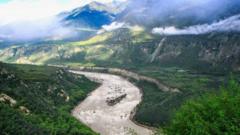The construction of the Yarlung Tsangpo dam in Tibet, touted as the largest hydropower project globally, ignites fears over potential community displacement and environmental repercussions in neighboring India and Bangladesh.
China to Construct World's Largest Hydropower Dam in Tibet Amid Controversy

China to Construct World's Largest Hydropower Dam in Tibet Amid Controversy
China's approval of the Yarlung Tsangpo dam project raises concerns about community displacement and environmental impact.
China has moved forward with plans to build the world's largest hydropower dam on the Yarlung Tsangpo River in Tibet, a decision that has sparked significant concerns about the displacement of local communities and potential ecological harm downstream in both India and Bangladesh. Announced in late 2020, the dam is expected to generate three times the electricity of the current largest dam, the Three Gorges Dam, according to Chinese state media.
While the Chinese government has branded the project as “safe and ecologically protective,” there are apprehensions from human rights advocates and experts regarding its broader implications. The construction is anticipated to greatly alter the landscape and threaten local ecosystems known for their rich diversity. Activists emphasize that this is yet another instance of Beijing’s exploitation of Tibetan territory and its inhabitants, following a long history of control since the 1950s annexation.
Earlier this year, protests erupted against another proposed dam in the region, resulting in significant crackdowns and violent responses from Chinese authorities. Meanwhile, government officials have claimed they relocated and compensated affected locals, although many remain skeptical of these promises.
Regarding the Yarlung Tsangpo project itself, state authorities have not disclosed how many people will be displaced, raising further alarm among locals and activists. The previous Three Gorges project necessitated the resettlement of approximately 1.4 million individuals, casting doubt over China's assurances for this new initiative.
The dam construction will involve extensive engineering work, including the drilling of several long tunnels through the Namcha Barwa mountains, potentially affecting river flow which traverses into India and Bangladesh. Experts warn that such control over the river may enhance China’s leverage over these neighboring nations, creating geopolitical tensions in the region.
In response to apprehensions from India, Chinese officials assert their "legitimate right" to dam the river, emphasizing that they are mindful of the downstream effects. Nonetheless, they have faced criticism from international observers who characterize their hydropower advancements in Tibet as detrimental to regional stability and environmental integrity.
As the dam project gears up, it faces harsh scrutiny over the environmental risks it may pose, especially given the area's susceptibility to earthquakes and landslides. Construction in such a terrain is fraught with danger, with experts warning that geological disturbances could greatly undermine the integrity of the dam.
Cost estimates for the Yarlung Tsangpo dam project have soared, predicting an expenditure of around a trillion yuan (approximately $127 billion), indicating the scale and ambition behind this monumental infrastructure endeavor.



















